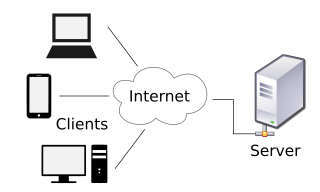
AOL is an American web portal and online service provider based in New York City, and a brand marketed by Yahoo! Inc.

A programmer, computer programmer or coder is an author of computer source code – someone with skill in computer programming.

ChatZilla is an IRC client that is part of SeaMonkey. It was previously an extension for Mozilla-based browsers such as Firefox, introduced in 2000. It is cross-platform open source software which has been noted for its consistent appearance across platforms, CSS appearance customization and scripting.

Online chat is any kind of communication over the Internet that offers a real-time transmission of text messages from sender to receiver. Chat messages are generally short in order to enable other participants to respond quickly. Thereby, a feeling similar to a spoken conversation is created, which distinguishes chatting from other text-based online communication forms such as Internet forums and email. Online chat may address point-to-point communications as well as multicast communications from one sender to many receivers and voice and video chat, or may be a feature of a web conferencing service.

Extensible Messaging and Presence Protocol is an open communication protocol designed for instant messaging (IM), presence information, and contact list maintenance. Based on XML, it enables the near-real-time exchange of structured data between two or more network entities. Designed to be extensible, the protocol offers a multitude of applications beyond traditional IM in the broader realm of message-oriented middleware, including signalling for VoIP, video, file transfer, gaming and other uses.

Yahoo! Messenger was an instant messaging client and associated protocol created and formerly operated by Yahoo!. Yahoo! Messenger was provided free of charge and could be downloaded and used with a generic "Yahoo ID" which also allowed access to other Yahoo! services, such as Yahoo! Mail.

Client is a computer that gets information from another computer called server in the context of client–server model of computer networks. The server is often on another computer system, in which case the client accesses the service by way of a network.
The landscape for instant messaging involves cross-platform instant messaging clients that can handle one or multiple protocols. Clients that use the same protocol can typically federate and talk to one another. The following table compares general and technical information for cross-platform instant messaging clients in active development, each of which have their own article that provide further information.
Infoseek was an American internet search engine founded in 1994 by Steve Kirsch.
Xoom was an early dot-com company that provided free unlimited space web hosting, similar to GeoCities. The domain "xoom.com" is now held by the Xoom Corporation, an international-focused money transfer website run by PayPal.

The Palace is a computer program to access graphical chat room servers, called palaces, in which users may interact with one another using graphical avatars overlaid on a graphical backdrop. The software concept was originally created by Jim Bumgardner and produced by Time Warner in 1994, and was first opened to the public in November 1995.

Web conferencing is used as an umbrella term for various types of online conferencing and collaborative services including webinars, webcasts, and web meetings. Sometimes it may be used also in the more narrow sense of the peer-level web meeting context, in an attempt to disambiguate it from the other types known as collaborative sessions. The terminology related to these technologies is exact and agreed relying on the standards for web conferencing but specific organizations practices in usage exist to provide also term usage reference.
The following tables compare general and technical information between a number of notable IRC client programs which have been discussed in independent, reliable prior published sources.

Skype for Business is an enterprise software application for instant messaging and videotelephony developed by Microsoft as part of the Microsoft 365 suite. It is designed for use with the on-premises Skype for Business Server software, and a software as a service version offered as part of 365. It supports text, audio, and video chat, and integrates with Microsoft 365 components such as Exchange and SharePoint.

MSN Messenger, later rebranded as Windows Live Messenger, was a cross-platform instant-messaging client developed by Microsoft. It connected to the now-discontinued Microsoft Messenger service and, in later versions, was compatible with Yahoo! Messenger and Facebook Messenger. The service was discontinued in 2013 and was replaced by Skype.

WebChat Broadcasting System, or WBS for short, is a virtual community created during the 1990s. Supported by online advertising, it was one of few services at the time to offer free integrated community services including chat rooms, message boards, and free personal web pages. Extremely popular during the mid to late 1990s in the era prior to the Dot-com bust, WBS was at that time the largest and best-known social media website on the internet. In 1998, WBS was acquired by the search engine Infoseek, which was in turn acquired by Disney/ABC. The original WebChat Broadcasting System closed on 15 September 1999 after its chat rooms were integrated into Disney's existing Go Network chat rooms. A revival of WBS was launched in 2009 and is virtually identical to the original community.

Atlassian Corporation is an Australian software company that specializes in collaboration tools designed primarily for software development and project management. The company is globally headquartered in Sydney, Australia, with a US headquarters in San Francisco, and over 12,000 employees across 14 countries. Atlassian currently serves over 300,000 customers in over 200 countries across the globe.

Microsoft Teams is a team collaboration application developed by Microsoft as part of the Microsoft 365 family of products, offering workspace chat and video conferencing, file storage, and integration of proprietary and third-party applications and services.

Element is a free and open-source software instant messaging client implementing the Matrix protocol.














